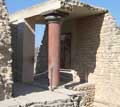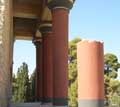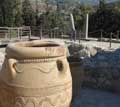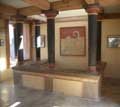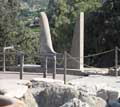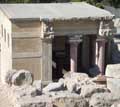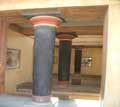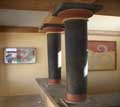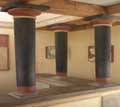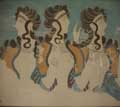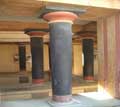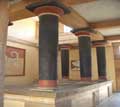
The most brilliant palatial center of Crete. It is the largest (20,000 m2) of all the Minoan power centers. The palace is built on a hill, in an area that was continuously inhabited from the Neolithic era to the pre-palatial years (7th - 3rd millennium BC). The first palace was built after 2000 BC. and was destroyed by an earthquake around 1700 BC. Immediately the second palace was built - larger, more luxurious and with a labyrinthine layout. The damage from an earthquake that occurred around 1600 BC. were repaired and the palace continued to function until 1450 BC, when the great seismic disaster occurred which leveled all the Minoan centers of Crete.
The palace was repaired and used during the first period of the "Mycenaean occupation" of Crete (1450 - 1350 BC), when Achaean rulers installed themselves on the throne of Knossos. The final destruction was due to fire. The palace included a large rectangular paved courtyard with a N. - S. axis, around which four wings were developed and where the same number of corridors ended. In the eastern wing were the apartments that have been interpreted as royal, the workshops and a sanctuary. In the west wing, the "throne room", the central sanctuary, the treasury and large storerooms, and on the second floor large ceremonial halls and sanctuaries. North and south were walled corridors leading out of the palace. The paved courtyard to the west of the palace with the "processional streets" was probably a ceremonial site. The palace was multi-storied, built with hewn structures and decorated with colorful frescoes. Some roofs were decorated with Minoan double horns. The water supply and drainage of the complex were done with clay pipes.
Around the palace, a rectangular theater, three circular granaries or storehouses and roads leading to the harbor and the city that grew on a large area around. Large buildings have been excavated from it, such as the "Little Palace", the "Royal Palace", the "House of Frescoes", the "Caravan Serai", the "House of the High Priest" etc. The city's cemeteries stretched all over the neighboring hills and included hundreds of vaulted and chambered tombs.
The excavation of Knossos yielded an extraordinarily large number of works of art, frescoes, sacred objects, vases, utensils and valuable records of Linear A and B writing, which shed light on the centuries-old history of the site where the center of Europe's first great civilization developed. The toponym Knossos is read on the Linear B writing tablets and the city retains the same name throughout the historical period. Settled by Dorians in the 11th BC, it flourished especially as a city in the Hellenistic era. At the end of the 1st c. BC it has the status of a Roman colony. Residential remains of the 10th c. BC to the N. and W. of the Minoan palace, where the market of the 6th c. BC and the temple of Apollo Pythios of classical times. Cemeteries in Fortetsa and Teke and the so-called "northern cemetery" (Geometric - Archaic and partly Hellenistic times). In the area of the palace, a classical temple, probably of Rhea, and to its west, a Hellenistic temple of Glaukos. Temples of Heracleus-Eurystheos and Demeter near the current Stratigraphic Museum. Hellenistic fortress at Kefala site. At the location of Bugada Metohi, a large building complex called "Mansion of Dionysus" with famous mosaic floors of the 2nd century A.D. Members of a Corinthian temple from Roman times were found near it. Next to the Archaeological Museum on Xanthoudidou street, Hellenistic-Roman buildings with mosaic floors. The Roman market (Forum) with basilica, baths, temple, and possibly a gallery. Also a Roman aqueduct. In the area of the Venizeli Hospital and the University of Crete, the city's cemetery with above-ground Roman tombs - mausoleums and heroes of the 1st - 2nd c. AD, as well as a ceramic workshop of the 4th c. A.D.
Sanctuary of Demeter on the slopes of Gypsadeo hill with remains of a temple, manors and precincts (functioning from the 8th century BC to the 2nd century AD). At the Sanatorio site, ruins of a three-aisled Early Christian cemetery basilica (5th - 6th century). In today's village of Knossos, the church of Agia Sophia is located on the site of an early Christian basilica (parts of it are preserved integrated into the modern building). The findings are exhibited at the Archaeological Museum of Heraklion.
Editor: Fotini Anastasopoulou










